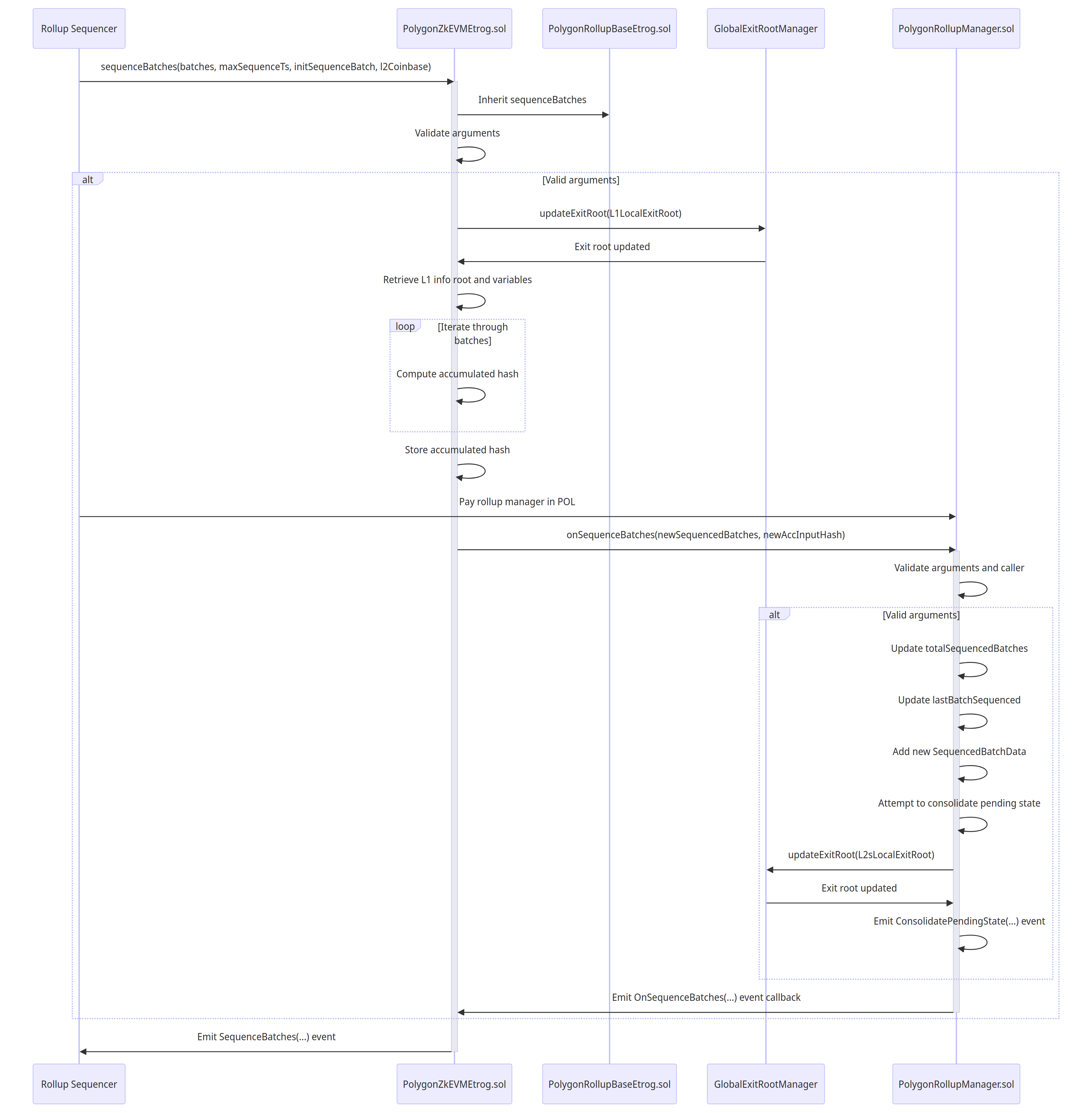Consensus contracts - sequencing
Transactions flowing through the system reach the smart contract environment after one of two contract call use cases:
- Sequence batches requests coming from the sequencer component in the node.
- Verifying batches requests coming from the aggregator component in the node.
This section focuses on the sequencing workflow.
The diagram below shows the sequencing workflow for rollup (non-validium) stacks which calls sequenceBatches(...) and onSequenceBatches(...).

sequenceBatches()¶
The sequenceBatches() function is called on the PolygonZkEVMEtrog.sol contract:
sequenceBatches(batches, maxSequenceTs, initSequenceBatch, l2Coinbase)
The rollup sequencer component calls the sequenceBatches function on the PolygonZkEVMEtrog.sol contract which inherits the function from PolygonRollupBaseEtrog.sol.
The function takes an array of BatchData structs from one of the consensus contracts. Each struct contains L2 Ethereum transactions data, and some forced state information.
struct BatchData {
bytes transactions;
bytes32 forcedGlobalExitRoot;
uint64 forcedTimestamp;
bytes32 forcedBlockHashL1;
}
The function validates arguments, checks and organizes the batches, and appends them in the correct sequence while computing an accumulated hash.
Finally, the function emits a SequenceBatches event which sends a newly sequenced batch of transactions to the PolygonRollupManager.sol contract after the onSequenceBatches(...) function returns successfully.
Stepwise, the function does the following:
- Validates arguments.
- Tells the bridge to update the global exit root by calling
globalExitRootManager.updateExitRoot(L1LocalExitRoot)which creates a new global exit root with the newest L1 local exit root. - Gets L1 info root and other variables needed for computation.
- Goes through the batches to compute the accumulated hash with
keccak(batch.transaction)andkeccak(accInputHash, txHash, l1InfoRoot, maxSequenceTs, l2Coinbase, bytes32(0)). - Stores the accumulated hash.
- Caller pays the rollup manager in POL.
- Calls the
PolygonRollupManager.onSequenceBatches(...)function which waits for anOnSequenceBatches(...)event callback. - Emits
SequenceBatches(...)event.
onSequenceBatches()¶
The onSequenceBatches() function is called on the PolygonRollupManager.sol contract:
onSequenceBatches(newSequencedBatches, newAccInputHash)
It takes the sequenced batches and the accumulated hash from the calling contract, adds the batches to the correct stack, and updates the batch count.
Stepwise, the function does the following:
- Validates the arguments and the caller contract.
- Updates the
totalSequencedBatchesstorage variable. - Updates the
lastBatchSequencedand adds a newSequencedBatchDatastruct for the rollup that calledsequenceBatches. - Attempts to consolidate pending state for the rollup by updating
lastVerifiedBatch,batchNumToStateRoot[], andlastLocalExitRootstate variables, and also by updatingglobalExitRootManager.updateExitRoot(L2sLocalExitRoot), after which it emits aConsolidatePendingState(...)event. - Emits an
OnSequenceBatches(...)event back to the originalsequenceBatches(...)call.
sequenceBatchesValidium()¶
The sequenceBatchesValidium() function is called on the PolygonValidiumEtrog.sol contract:
sequenceBatchesValidium(batches, l2Coinbase, dataAvailabilityMessage)
Info
- This function is not included in the sequence diagram above.
- The differences, however, are minimal.
The sequencing logic is nearly the same as for the rollup sequenceBatches(...) function except the function takes a ValidiumBatchData[] array instead of BatchData[]. This means that, instead of passing the actual transaction data, the struct passes the hashes of the transactions.
struct ValidiumBatchData {
bytes32 transactionsHash;
bytes32 forcedGlobalExitRoot;
uint64 forcedTimestamp;
bytes32 forcedBlockHashL1;
}
It also has a dataAvailabilityMessage parameter instead of the sequence information. This parameter contains all the ECDSA address signatures of the committee in ascending order and is used for verification.
Stepwise, the function has identical logic to the PolygonRollupBaseEtrog.sequenceBatches(...) function apart from the following steps:
ValdiumBatchDatainstead ofBatchData.- Accumulates the txHash into
accumulatedNonForcedTransactionHash. - Adds a validity check with
dataAvailabilityProtocol.verifyMessage(accumulatedNonForcedTransactionHash, dataAvailabilityMessage).